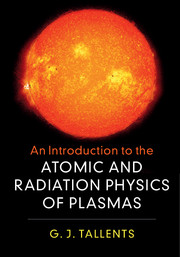Book contents
- Frontmatter
- Contents
- Preface
- 1 Plasma and Atomic Physics
- 2 The Propagation of Light
- 3 Scattering
- 4 Radiation Emission in Plasmas
- 5 Radiation Emission Involving Free Electrons
- 6 Opacity
- 7 Discrete Bound Quantum States: Hydrogen and Hydrogen-Like Ions
- 8 Discrete Bound States: Many-Electron Atoms and Ions
- 9 Discrete Bound States: Molecules
- 10 Radiative Transitions between Discrete Quantum States
- 11 Collisions
- 12 Collisional-Radiative Models
- 13 High-Density Plasmas
- Appendix Vectors, Maxwell's Equations, the Harmonic Oscillator and a Sum Rule
- References
- Index
7 - Discrete Bound Quantum States: Hydrogen and Hydrogen-Like Ions
Published online by Cambridge University Press: 21 February 2018
- Frontmatter
- Contents
- Preface
- 1 Plasma and Atomic Physics
- 2 The Propagation of Light
- 3 Scattering
- 4 Radiation Emission in Plasmas
- 5 Radiation Emission Involving Free Electrons
- 6 Opacity
- 7 Discrete Bound Quantum States: Hydrogen and Hydrogen-Like Ions
- 8 Discrete Bound States: Many-Electron Atoms and Ions
- 9 Discrete Bound States: Molecules
- 10 Radiative Transitions between Discrete Quantum States
- 11 Collisions
- 12 Collisional-Radiative Models
- 13 High-Density Plasmas
- Appendix Vectors, Maxwell's Equations, the Harmonic Oscillator and a Sum Rule
- References
- Index
Summary
An important type of emission from plasmas consists of spectral lines originating from transitions between bound quantum states. Quantum mechanics gives information on the energies of the quantum states and can give information on the intensity of emission. The absorption of radiation resulting in transitions between bound quantum states can dominate the calculation of absorption coefficients, particularly for higher atomic number ions where the spectral density of absorption and emission lines is large and the radiative-transition probabilities are high (for example, hydrogen-like ion transition probabilities scale proportionally to Z 4).
The Bohr model of the atom where electrons are said to orbit the nucleus like planets orbiting the Sun was introduced in Section 1.5. The Bohr model gives a good approximation of the energies of hydrogen and hydrogen-like ions. It is also a reasonable model for the energies of excited states of higher-atomic-number atoms and ions. Excited electrons of multi-electron atoms and ions have orbits some distance from the nucleus and other electrons, so their kinetic and potential energy is determined by the near point-like net charge near the nucleus as occurs with hydrogen-like ions. The Bohr model, however, fails to predict the correct angular momentum of orbiting electrons and fails to predict the fine structure of the energy levels. Fine structure causes, for example, the energy states to split and produce two or more closely spaced spectral lines, rather than a single line. The Bohr model also does not enable a satisfactory method of evaluating the rates of radiative absorption and emission (which can be done with time-dependent quantum mechanics; see Section 10.1).
We consider the quantum mechanics of hydrogen and hydrogen-like ions in this chapter. Hydrogen and hydrogen-like ions only differ in the charge Z of the nucleus, so it is possible to treat both almost identically. We commence with solutions of the Schrodinger equation, treat the effects leading to the fine structure and mention hyperfine energy splitting arising from electron interaction with the nuclear spin. There are many books dealing with the details of the quantum mechanics of hydrogen. We refer the reader to Haken and Wolf [43] for further reading.
A Quantum Mechanical Treatment of Atoms and Ions
A quantum mechanical treatment of atoms and ions can start with the timedependent Schrodinger equation.
- Type
- Chapter
- Information
- An Introduction to the Atomic and Radiation Physics of Plasmas , pp. 127 - 151Publisher: Cambridge University PressPrint publication year: 2018

